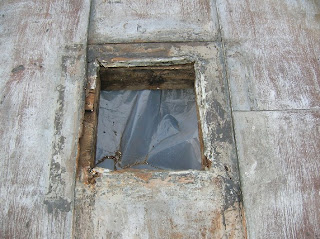I got up on the roof with most of the supplies and tools needed. Erika brought me more as I called out for them. Got up there at around 6:30PM and started removing the bolts.
This was nerve-racking work. I didn't know what I'd find when I pulled this old patch off, and I wasn't even 100% sure that I'd know what to do in building a more effective patch.
Once it was off, I spent a couple of hours with the putty knife and wire brush cleaning the horrible mess.
Ultimately, this and a couple of neighboring roof panels will need to be replaced. Without a doubt. Some of the seams are completely rusted out, and some of the panel a little down stream is also totally rusted through, held together only by some compound that I wisely stopped short of removing.
Once it was cleaned up, I sat upstream from the nearly 24"x24" gaping hole in the roof and thought "be the rain, be the roof."
Here's what I ended up doing: I cut a piece of 12" wide sheet metal flashing to fit lengthwise between the seams (24"). That was sealed to the roof about 8"-10" downstream of the hole. Then I cut another piece and overlapped it by several inches, a little further upstream. Did the same with a third piece, this one now covered the first few inches of the hole. Then I layed down the 24"x24" square of 19 guage galvanized steel over the entire hole. Actually, this needed to be trimmed an inch or so, which wasn't easy with my stubby sheetmetal shears. I cut my hand no less than 5 times in 24" doing this. Once that was set and sealed, I added another piece of flashing upstream and overlapping a few inches. Finally, a fifth piece of flashing was added at the top. With this one, I was able to slide it under the existing horizontal seam of the upper roof panel.
So what we're left with is basically like a shingle system where every piece overlaps the next as the water runs down it. The left the standing seams at the edges as the only place water could get in. So, I sealed and tooled and sealed along those seams.
Why should this patch work and the old one not? Lots of reasons. But I think that by not trying to mold to the existing seams is one trick. The other trick will be the Geocell 2300 Tripolymer Construction Sealant (love saying that) that I used. It remains flexible, which is key. Tar does not. Metal roofs do a lot of flexing with temperature, wind, and traffic.
By 10 o'clock or so I was down from the roof. Filthy and tired. A couple of hours later I was in bed and just falling off to sleep when I noticed lightning in the sky, far off. Consequently, I awoke every 20 minutes as the storm drew closer. Part of me wanted it to hit us hard, part of me wanted another day to check my work and finish up. By 2 AM, the storm was dumping on us. I got up with the flashlight and went to the kitchen and looked up at the patch. No sign of leakage. Back to sleep. No sign in the morning either.
Was it just a dream? Did it really work? Tonight I will give it one more nice bead of sealant and then tape some paper up to the ceiling so that we can really monitor this.
- John
Before:

Vent removed:


Cleaned up:


After (Now I know these pics are terrible but I was ready to get off the roof by now. Tonight I plan to clean this up and I'll get some better shots):
Looking upstream:

Looking downstream:


3 comments:
It really didn't leak, so your plan worked. Is the fix that you did still there, preventing the rain from seeping in? At least, you didn't have to replace the whole roof, or a big portion of it. I hope it holds well until now.
Four years later and it's still holding up, Rodney. The leak at the existing chimney by the ridge is another story, however...
Post a Comment